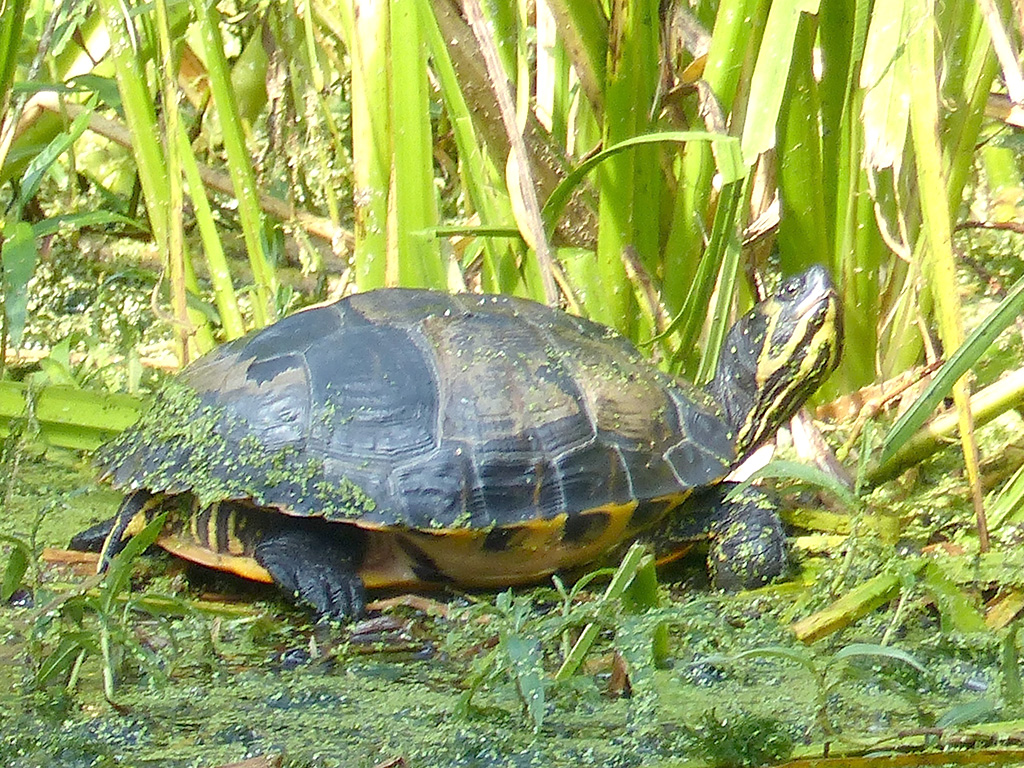
Naturalists in East Yorkshire are appealing for more reports of terrapin sightings in Holderness after they were surprised to find records of the non-native animals at numerous sites across Hull and the East Riding.
In a study published this summer, Dr Africa Gómez, a senior lecturer in biological sciences at the University of Hull, and Dr Richard Shillaker from the Hull Natural History Society, revealed that terrapins had been spotted at 32 sites across East Yorkshire.
For the study in The Naturalist – the journal of the Yorkshire Naturalists’ Union – the researchers reviewed existing data from a range of sources and appealed for new information via social media. They discovered 10 sites in Hull and 22 in the East Riding where terrapins had been spotted living.
Their numbers are thought to derive largely from the Teenage Mutant Ninja Turtles craze in the 1990s, when terrapins were bought and then abandoned when no longer wanted. The small freshwater turtles are called terrapins in the UK, but in the US, they and their marine counterparts are both called turtles.
The most frequently kept pet terrapins were red-eared sliders (also called red-eared terrapins) and yellow-bellied terrapins, which both originate from central/southern USA. These terrapins can survive UK winters by hibernating at the bottom of ponds, but they are not thought capable of successful breeding because British summers are not warm enough for long enough for eggs to hatch. The researchers said that no reproductive behaviour was discovered during their study.
These two types of terrapins are considered to feed mostly on plant material, aquatic invertebrates, tadpoles and small fish, and they can live for about 40 years in the wild.
Although there are reports of terrapins being released into the wild in the UK since Victorian times, the earliest definite terrapin record in East Yorkshire is from Brandesburton in 1992.
More recent terrapin sightings in our region include one in the Holderness Drain, in 2017, another that was caught by a rod and line fisherman in Leven Canal in June 2015, and a terrapin found on Mappleton beach in August 2017 which was taken to a vet. There were also reports of up to three terrapins being present in the car park pond at the Paull Holme Strays nature reserve in 2020 and 2021, and a single terrapin was spotted there in 2017.
Terrapins are mostly seen when they are basking out of the water, such as on a fallen branch, so because they may usually be out of sight, their numbers are likely to be under-recorded. There are a variety of species of terrapin, but they are not easily identifiable as the differences between them can be subtle, and it is not often possible to get a clear view of them in their habitat, the researchers said.
Where identification was achieved, the terrapins were mostly red-eared sliders or yellow-bellied sliders. Two map turtles, six cooters and a Chinese softshell turtle were also recorded, as well as two slider hybrids, and there was a report of a giant musk turtle.
However, there were doubts surrounding a claimed sighting of several European pond terrapins.
Dr Gómez said: “Introduced species often get bad press – for example, terrapins are blamed for the loss of ducklings or other water birds. However, there is little evidence for this. Pike and gulls are likely to represent more serious predatory threats to chicks than terrapins. However, we don’t know enough about the diet and ecological impacts of introduced terrapins, and this should be the focus of further research.
“The continued presence of terrapins in Hull and East Yorkshire will depend on the balance of recruitment to, and loss from, the current population. Without further illegal abandonment of these unwanted pets into the wild, the terrapin population in Hull and East Yorkshire will probably eventually die out.
“Terrapins are still offered for sale as pets in the UK but all species – including the European pond terrapin, are regarded as non-native in the UK – hence, releasing any terrapin into the environment in the UK is an offence.”
Dr Shillaker said it was vital to make sure that unwanted pet terrapins were safely rehomed and not released into the wild.
He said: “If you have one that you no longer able to keep, the National Centre for Reptile Welfare offers a rehoming service. NCRW is based in Kent but has terrapin drop-off points all around the UK including one in Hull. For more information, contact NCRW on 07897 692060 or [email protected].”
The researchers are still on the lookout for terrapin sightings, especially in Holderness. Dr Shillaker added: “With the air temperature dropping as we move further into winter, there are unlikely to be any sightings of terrapins basking. However, records from earlier this year, or from previous years, are still most welcome.”
If you have seen or photographed a terrapin in the region, contact Dr Gomez at [email protected].




